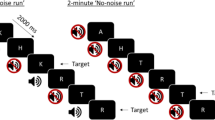Abstract
Three groups of 12 subjects each performed a mental arithmetic task while exposed to continuous white noise in two experimental sessions. In Session I, each group was exposed to a different noise level [56, 72.5, or 85dB(A)], whereas in Session II all had the medium [72.5 dB(A)] intensity. Arithmetic performance deteriorated with increasing noise intensity in Session I, and in Session II each group retained its position relative to the other two groups. Thus, the higher the noise intensity in the first session, the poorer the performance in the second session. These results suggest that the motivation and energy mobilized in Session II were determined by the cognitive set adopted to meet the demands of Session I. Arousal level, as measured by adrenaline excretion and heart rate, was higher during both experimental sessions than in a control session. The rise in adrenaline output was of the same magnitude regardless of the intensity of the noise, which indicates that the subjects adjusted to the increase in total load by slowing down their performance rather than by raising their energy mobilization. Heart rate rose in response to changes in noise level in Session II relative to Session I, regardless of the direction of the change.
Similar content being viewed by others
References
Andersson, B., Hovmöller, S., Karlsson, C.-G., & Svensson, S. Analysis of urinary catecholamines: An improved auto-analyzer fluorescence method.Clinica Chimica Acta 1974,51 13–28.
Berlyne, D. E., Borsa, D. M., Hamacher, J. H., & Koenig, I. D. V. Paired-associate learning and the timing of arousal.Journal of Experimental Psychology 1966,72 1–6.
Broadbent, D. E. Effect of noise on an “intellectual” task.Journal of Acoustical Society of America 1958,30 824–827.
Corcoran, D. W. J. Noise and loss of sleep.Quarterly Journal of Experimental Psychology 1962,14 178–182.
Davis, R. C., Buchwald, A. M., & Frankmann, R. W. Autonomic and muscular responses, and their relation to simple stimuli.Psychological Monographs: General and Applied, 1955,69(20, Whole No. 405).
Euler, U. S. v., & Lishajko, F. Improved technique for the fluorimetric estimation of catecholamines.Acta Physiologica Scandinavica 1961,51 348–355.
Frankenhaeuser, M. Behavior and circulating catecholamines.Brain Research 1971,31 241–262.
Frankenhaeuser, M. Sympathetic-adrenomedullary activity, behaviour and the psychosocial environment. In P. H. Venables & M. J. Christie (Eds.),Research in psychophysiology. New York: Wiley, 1975. Chap. 4, pp. 71–94.
Frankenhaeuser, M. The role of peripheral catecholamines in adaptation to understimulation and overstimulation. In G. Serban (Ed.),The psychopathology of human adaptation. New York: Plenum Press, 1976, pp. 173–182.
Frankenhaeuser, M., & Johansson, G. Task demand as reflected in catecholamine excretion and heart rate.Journal of Human Stress 1976,2 15–33.
Frankenhaeuser, M., & Lundberg, U. Immediate and delayed effects of noise on performance and arousal.Biological Psychology 1974,2 127–133.
Glass, D. C., & Singer, J. E.Urban stress. Experiments on noise and social stressors. New York: Academic Press, 1972.
Gulian, E. Effects of prior acoustic conditions on performance and its psychophysiological correlates.Revue Roumaine des Sciences Sociales-Serie de Psychologie 1974,18(1), 25–35.
International Organization for Standardization.Method for calculating loudness level. ISO/R 532–1966 (E).
Jerison, H. J. Effects of noise on human performance.Journal of Applied Psychology 1959,43 96–101.
Kahneman, D.Attention and effort. Englewood Cliffs, New Jersey: Prentice-Hall, 1973.
Lundberg, U. Urban commuting: Crowdedness and catecholamine excretion.Journal of Human Stress 1976,2 26–32.
Selye, H.Stress without distress. Philadelphia/New York: Lippincott, 1974.
Singer, J. E., Lundberg, U., & Frankenhaeuser, M. Stress on the train: A study of urban commuting.Advances in Environmental Research, in press.
Sokolov, E. N.Perception and the conditioned reflex. New York: Macmillan, 1963.
Stevens, S. S. Perceived level of noise by Mark VII and decibels (E).Journal of the Acoustical Society of America 1972,51 575–601. (a)
Stevens, S. S.Psychophysics and social scaling. Morristown: General Learning Press, 1972. (b)
Author information
Authors and Affiliations
Additional information
Financial support was obtained from the Swedish Medical Research Council (Project No. 997) and the Swedish Council for Social Science Research. Lennart Forsman and Gunnar Mellander assisted in the collection and treatment of the data, and Lars Holmberg performed the catecholamine analyses.
Rights and permissions
About this article
Cite this article
Frankenhaeuser, M., Lundberg, U. The influence of cognitive set on performance and arousal under different noise loads. Motiv Emot 1, 139–149 (1977). https://doi.org/10.1007/BF00998516
Issue Date:
DOI: https://doi.org/10.1007/BF00998516




